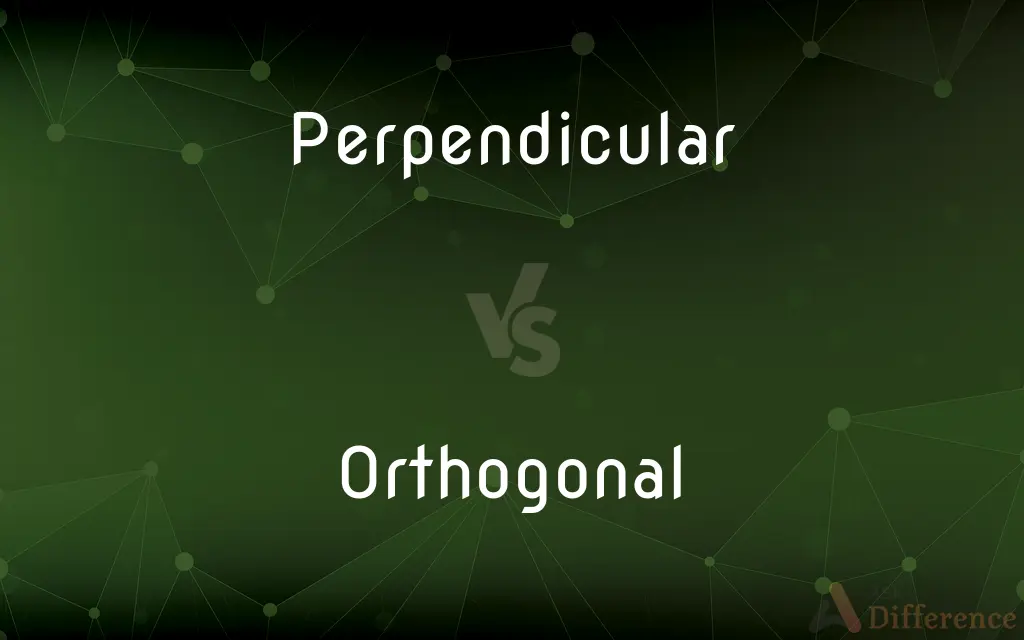Perpendicular vs. Orthogonal — What's the Difference?
By Tayyaba Rehman — Updated on September 4, 2023
Perpendicular refers to two lines meeting at a right angle, while orthogonal can mean the same but also refers to being independent or unrelated in various contexts.

Difference Between Perpendicular and Orthogonal
Table of Contents
ADVERTISEMENT
Key Differences
Perpendicular and Orthogonal are terms often used interchangeably in geometry to describe lines or planes that meet at a right angle. However, their usages have nuances that distinguish them. Perpendicular is a term specifically tied to geometrical contexts, referring to lines or planes that intersect at 90 degrees. Orthogonal, while also used in this geometric sense, has broader applications.
Outside of geometry, Orthogonal is a term borrowed in other fields like statistics, computer science, and engineering. In these contexts, Orthogonal might not strictly pertain to angles but to concepts of independence or non-overlap. Perpendicular, on the other hand, retains its geometric meaning and doesn’t translate to these broader contexts.
In linear algebra, vectors are said to be Orthogonal if their dot product is zero, indicating they are at right angles. Here, the term Orthogonal is favored over Perpendicular because of its connotations with independence and lack of correlation.
In statistics, Orthogonal describes variables that are uncorrelated. When two factors are Orthogonal, they don't overlap in variance. This is a departure from the strict right-angle connotation of Perpendicular and showcases the versatility of the term Orthogonal.
While both Perpendicular and Orthogonal can describe right angles, their usage is differentiated by context. Perpendicular is best suited for purely geometric contexts, whereas Orthogonal finds its place in both geometry and in describing independent, non-overlapping concepts in various fields.
ADVERTISEMENT
Comparison Chart
Primary Definition
Refers to lines/planes intersecting at 90 degrees
Refers to lines/planes intersecting at 90 degrees
Usage Scope
Mainly geometrical
Geometrical and other fields like statistics
Linear Algebra
Less common terminology
Vectors are orthogonal if their dot product is zero
Statistics
Not used
Describes uncorrelated variables
Broader Meaning
Doesn’t have broader meanings outside geometry
Can mean independent or unrelated
Compare with Definitions
Perpendicular
Perpendicular refers to two lines that intersect at a right angle.
The two streets are perpendicular to each other.
Orthogonal
Orthogonal refers to entities intersecting at a right angle.
The grid was made of orthogonal lines.
Perpendicular
Perpendicular can refer to a line or plane that's at 90 degrees to another.
The ladder was perpendicular to the wall.
Orthogonal
Orthogonal is used in linear algebra to describe vectors with a dot product of zero.
The vectors are orthogonal in space.
Perpendicular
Perpendicular is used in geometry to describe right-angle intersections.
The two line segments are perpendicular.
Orthogonal
Orthogonal can mean independent or unrelated, especially outside geometry.
The two concepts are orthogonal to each other.
Perpendicular
Perpendicular means standing straight up, especially at a right angle.
The post was perpendicular to the ground.
Orthogonal
Orthogonal can describe designs or systems with independent components.
The device’s features are orthogonal; changing one won’t affect the others.
Perpendicular
Perpendicular can describe a relationship of complete difference.
Their views are perpendicular; they’ll never agree.
Orthogonal
Orthogonal in statistics describes uncorrelated variables.
Those factors are orthogonal in the analysis.
Perpendicular
In elementary geometry, the property of being perpendicular (perpendicularity) is the relationship between two lines which meet at a right angle (90 degrees). The property extends to other related geometric objects.
Orthogonal
Of or involving right angles; at right angles.
Perpendicular
At an angle of 90° to a given line, plane, or surface or to the ground
Dormers and gables that extend perpendicular to the main roofline
Orthogonal
(of variates) statistically independent.
Perpendicular
Denoting the latest stage of English Gothic church architecture, prevalent from the late 14th to mid 16th centuries and characterized by broad arches, elaborate fan vaulting, and large windows with vertical tracery
The Perpendicular style
The handsome Perpendicular church of St Andrew
Orthogonal
Relating to or composed of right angles.
Perpendicular
A straight line at an angle of 90° to a given line, plane, or surface
At each division draw a perpendicular representing the surface line
Orthogonal
Of or relating to a matrix whose transpose equals its inverse.
Perpendicular
(Mathematics) Intersecting at or forming right angles.
Orthogonal
Of or relating to a linear transformation that preserves the length of vectors.
Perpendicular
Being at right angles to the horizontal; vertical.
Orthogonal
Very different or unrelated; sharply divergent
"Radical Islamists are ultimately seeking to create something orthogonal to our model of democracy" (Richard A. Clarke).
Perpendicular
Often Perpendicular Of or relating to a style of English Gothic architecture of the 1300s and 1400s, characterized by the use of fan vaulting and broad windows with many mullions.
Orthogonal
(geometry) Of two objects, at right angles; perpendicular to each other.
A chord and the radius that bisects it are orthogonal.
Perpendicular
In a perpendicular position.
Orthogonal
(mathematics)
Perpendicular
(Mathematics) A line or plane perpendicular to a given line or plane.
Orthogonal
Of a pair of vectors: having a zero inner product; perpendicular.
The normal vector and tangent vector at a given point are orthogonal.
Perpendicular
A perpendicular position.
Orthogonal
Of a square matrix: such that its transpose is equal to its inverse.
Perpendicular
A device, such as a plumb line, that is used in marking the vertical from a given point.
Orthogonal
Of a linear transformation: preserving its angles.
Perpendicular
A vertical or nearly vertical line or plane.
Orthogonal
Of grid graphs, board games and polyominoes: vertical or horizontal but not diagonal.
Perpendicular
(geometry) At or forming a right angle (to something).
In most houses, the walls are perpendicular to the floor.
Orthogonal
Of a pair of elements in an ortholattice: each less than or equal to the orthocomplement of the other.
Perpendicular
Exactly upright; extending in a straight line toward the centre of the earth, etc.
Orthogonal
(statistics) Statistically independent, with reference to variates.
Perpendicular
Independent of or irrelevant to each other; orthogonal.
Orthogonal
(software engineering) Of two or more aspects of a problem, able to be treated separately; of a design, exhibiting consistency and composability.
The content of the message should be orthogonal to the means of its delivery.
Perpendicular
(geometry) A line or plane that is perpendicular to another.
Orthogonal
Of two or more problems or subjects, independent of or irrelevant to each other.
Perpendicular
A device such as a plumb line that is used in making or marking a perpendicular line.
Orthogonal
An orthogonal line
Perpendicular
A meal eaten at a tavern bar while standing up.
Orthogonal
Right-angled; rectangular; as, an orthogonal intersection of one curve with another.
Perpendicular
Exactly upright or vertical; pointing to the zenith; at right angles to the plane of the horizon; extending in a right line from any point toward the center of the earth.
Orthogonal
Not pertinent to the matter under consideration;
An issue extraneous to the debate
The price was immaterial
Mentioned several impertinent facts before finally coming to the point
Perpendicular
At right angles to a given line or surface; as, the line ad is perpendicular to the line bc.
Orthogonal
Statistically unrelated
Perpendicular
A line at right angles to the plane of the horizon; a vertical line or direction.
Orthogonal
Having a set of mutually perpendicular axes; meeting at right angles;
Wind and sea may displace the ship's center of gravity along three orthogonal axes
A rectangular Cartesian coordinate system
Perpendicular
A line or plane falling at right angles on another line or surface, or making equal angles with it on each side.
Perpendicular
A straight line at right angles to another line
Perpendicular
A Gothic style in 14th and 15th century England; characterized by vertical lines and a four-centered (Tudor) arch and fan vaulting
Perpendicular
A cord from which a metal weight is suspended pointing directly to the earth's center of gravity; used to determine the vertical from a given point
Perpendicular
An extremely steep face
Perpendicular
Intersecting at or forming right angles;
The axes are perpendicular to each other
Parallel lines never converge
Concentric circles are parallel
Dancers in two parallel rows
Perpendicular
At right angles to the plane of the horizon or a base line;
A vertical camera angle
The monument consists of two vertical pillars supporting a horizontal slab
Measure the perpendicular height
Perpendicular
Extremely steep;
The great perpendicular face of the cliff
Common Curiosities
What does orthogonal mean in linear algebra?
Vectors are orthogonal if their dot product is zero.
Can orthogonal mean unrelated or independent?
Yes, especially in fields outside of geometry.
Are orthogonal concepts always geometric?
No, they can refer to independence or non-overlap in various fields.
Do both perpendicular and orthogonal describe right angles?
Yes, in geometry, both terms can describe right angles.
Is perpendicular used outside of geometry?
Not commonly; its primary meaning is geometrical.
How is perpendicular used in everyday language?
It often describes things that stand or intersect at right angles.
Are perpendicular and orthogonal interchangeable?
In geometry, often yes, but orthogonal has broader meanings in other contexts.
Can you give an example of perpendicular used outside geometry?
While rare, it might describe opposing views or stances.
What does orthogonal mean in statistics?
It describes variables that are uncorrelated.
Which term, perpendicular or orthogonal, is broader in scope?
Orthogonal is broader, encompassing geometric and non-geometric meanings.
Can two ideas be orthogonal?
Yes, in a metaphorical sense, meaning they’re independent or unrelated.
How are perpendicular and orthogonal similar?
Both can describe lines or planes that intersect at 90 degrees.
Is a perpendicular intersection always 90 degrees?
Yes, it describes an intersection at a right angle.
In what context might one prefer orthogonal over perpendicular?
In discussing independence, lack of overlap, or non-geometric right angles.
How do orthogonal systems work in design?
Features are independent; altering one doesn’t impact the others.
Share Your Discovery

Previous Comparison
Collaborate vs. Corroborate
Next Comparison
City vs. TownAuthor Spotlight
Written by
Tayyaba RehmanTayyaba Rehman is a distinguished writer, currently serving as a primary contributor to askdifference.com. As a researcher in semantics and etymology, Tayyaba's passion for the complexity of languages and their distinctions has found a perfect home on the platform. Tayyaba delves into the intricacies of language, distinguishing between commonly confused words and phrases, thereby providing clarity for readers worldwide.














































